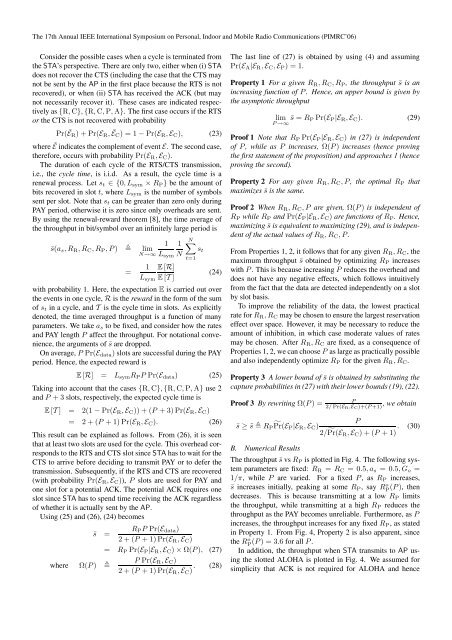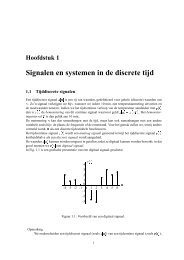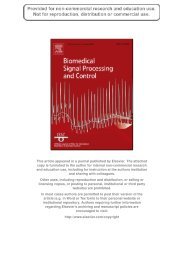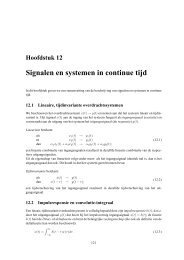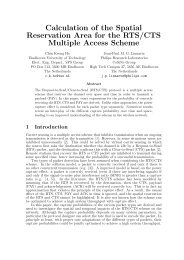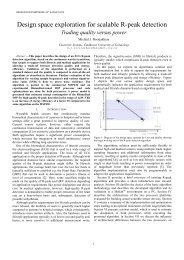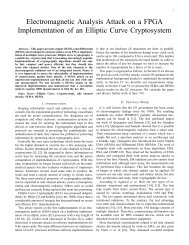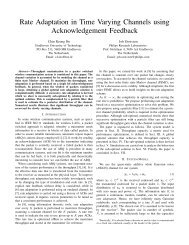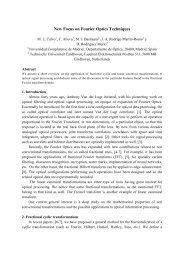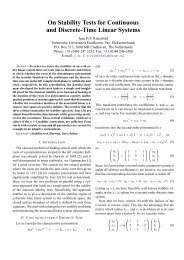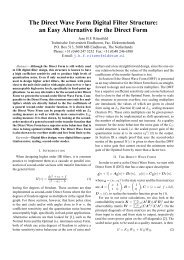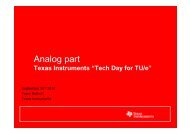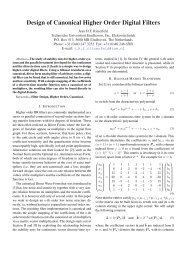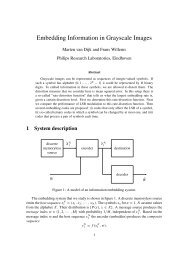analysis of the rts/cts multiple access scheme with capture effect
analysis of the rts/cts multiple access scheme with capture effect
analysis of the rts/cts multiple access scheme with capture effect
Create successful ePaper yourself
Turn your PDF publications into a flip-book with our unique Google optimized e-Paper software.
The 17th Annual IEEE International Symposium on Personal, Indoor and Mobile Radio Communications (PIMRC’06)<br />
The last line <strong>of</strong> (27) is obtained by using (4) and assuming<br />
Consider <strong>the</strong> possible cases when a cycle is terminated from<br />
where Ω(P ) <br />
P Pr(E R , E C )<br />
2 + (P + 1) Pr(E R , E C ) . (28) ing <strong>the</strong> slotted ALOHA is plotted in Fig. 4. We assumed for<br />
simplicity that ACK is not required for ALOHA and hence<br />
<strong>the</strong> STA’s perspective. There are only two, ei<strong>the</strong>r when (i) STA Pr(E A |E R , E C , E P ) = 1.<br />
does not recover <strong>the</strong> CTS (including <strong>the</strong> case that <strong>the</strong> CTS may<br />
not be sent by <strong>the</strong> AP in <strong>the</strong> first place because <strong>the</strong> RTS is not<br />
recovered), or when (ii) STA has received <strong>the</strong> ACK (but may<br />
not necessarily recover it). These cases are indicated respectively<br />
Property 1 For a given R R , R C , R P , <strong>the</strong> throughput ¯s is an<br />
increasing function <strong>of</strong> P . Hence, an upper bound is given by<br />
<strong>the</strong> asymptotic throughput<br />
as {R, C}, {R, C, P, A}. The first case occurs if <strong>the</strong> RTS<br />
or <strong>the</strong> CTS is not recovered <strong>with</strong> probability<br />
lim P Pr(E P |E R , E C ).<br />
P →∞<br />
(29)<br />
Pr(ĒR) + Pr(E R , ĒC) = 1 − Pr(E R , E C ), (23)<br />
Pro<strong>of</strong> 1 Note that R P Pr(E P |E R , E C ) in (27) is independent<br />
where Ē indicates <strong>the</strong> complement <strong>of</strong> event E. The second case,<br />
<strong>the</strong>refore, occurs <strong>with</strong> probability Pr(E R , E C ).<br />
The duration <strong>of</strong> each cycle <strong>of</strong> <strong>the</strong> RTS/CTS transmission,<br />
<strong>of</strong> P , while as P increases, Ω(P ) increases (hence proving<br />
<strong>the</strong> first statement <strong>of</strong> <strong>the</strong> proposition) and approaches 1 (hence<br />
proving <strong>the</strong> second).<br />
i.e., <strong>the</strong> cycle time, is i.i.d. As a result, <strong>the</strong> cycle time is a<br />
renewal process. Let s t ∈ {0, L sym × R P } be <strong>the</strong> amount <strong>of</strong><br />
bits recovered in slot t, where L sym is <strong>the</strong> number <strong>of</strong> symbols<br />
Property 2 For any given R R , R C , P , <strong>the</strong> optimal R P that<br />
maximizes ¯s is <strong>the</strong> same.<br />
sent per slot. Note that s t can be greater than zero only during<br />
PAY period, o<strong>the</strong>rwise it is zero since only overheads are sent. Pro<strong>of</strong> 2 When R R , R C , P are given, Ω(P ) is independent <strong>of</strong><br />
By using <strong>the</strong> renewal-reward <strong>the</strong>orem [8], <strong>the</strong> time average <strong>of</strong> R P while R P and Pr(E P |E R , E C ) are functions <strong>of</strong> R P . Hence,<br />
<strong>the</strong> throughput in bit/symbol over an infinitely large period is maximizing ¯s is equivalent to maximizing (29), and is independent<br />
<strong>of</strong> <strong>the</strong> actual values <strong>of</strong> R R , R C , P .<br />
1 1<br />
N∑<br />
¯s(a s , R R , R C , R P , P ) lim<br />
s t<br />
N→∞ L sym N<br />
From Properties 1, 2, it follows that for any given R R , R C , <strong>the</strong><br />
t=1<br />
maximum throughput ¯s obtained by optimizing R P increases<br />
1 E [R]<br />
=<br />
(24) <strong>with</strong> P . This is because increasing P reduces <strong>the</strong> overhead and<br />
L sym E [T ]<br />
does not have any negative effe<strong>cts</strong>, which follows intuitively<br />
<strong>with</strong> probability 1. Here, <strong>the</strong> expectation E is carried out over<br />
<strong>the</strong> events in one cycle, R is <strong>the</strong> reward in <strong>the</strong> form <strong>of</strong> <strong>the</strong> sum<br />
<strong>of</strong> s t in a cycle, and T is <strong>the</strong> cycle time in slots. As explicitly<br />
denoted, <strong>the</strong> time averaged throughput is a function <strong>of</strong> many<br />
parameters. We take a s to be fixed, and consider how <strong>the</strong> rates<br />
and PAY length P affect <strong>the</strong> throughput. For notational convenience,<br />
<strong>the</strong> arguments <strong>of</strong> ¯s are dropped.<br />
On average, P Pr(E data ) slots are successful during <strong>the</strong> PAY<br />
period. Hence, <strong>the</strong> expected reward is<br />
from <strong>the</strong> fact that <strong>the</strong> data are detected independently on a slot<br />
by slot basis.<br />
To improve <strong>the</strong> reliability <strong>of</strong> <strong>the</strong> data, <strong>the</strong> lowest practical<br />
rate for R R , R C may be chosen to ensure <strong>the</strong> largest reservation<br />
<strong>effect</strong> over space. However, it may be necessary to reduce <strong>the</strong><br />
amount <strong>of</strong> inhibition, in which case moderate values <strong>of</strong> rates<br />
may be chosen. After R R , R C are fixed, as a consequence <strong>of</strong><br />
Properties 1, 2, we can choose P as large as practically possible<br />
and also independently optimize R P for <strong>the</strong> given R R , R C .<br />
E [R] = L sym R P P Pr(E data ) (25) Property 3 A lower bound <strong>of</strong> ¯s is obtained by substituting <strong>the</strong><br />
Taking into account that <strong>the</strong> cases {R, C}, {R, C, P, A} use 2 <strong>capture</strong> probabilities in (27) <strong>with</strong> <strong>the</strong>ir lower bounds (19), (22).<br />
and P + 3 slots, respectively, <strong>the</strong> expected cycle time is<br />
P<br />
Pro<strong>of</strong> 3 By rewriting Ω(P ) =<br />
2/ Pr(E R,E C)+(P +1)<br />
, we obtain<br />
E [T ] = 2(1 − Pr(E R , E C )) + (P + 3) Pr(E R , E C )<br />
= 2 + (P + 1) Pr(E R , E C ). (26)<br />
P<br />
¯s ≥ ˜s R P˜Pr(EP |E R , E C )<br />
This result can be explained as follows. From (26), it is seen<br />
2/˜Pr(E R , E C ) + (P + 1) . (30)<br />
that at least two slots are used for <strong>the</strong> cycle. This overhead corresponds<br />
to <strong>the</strong> RTS and CTS slot since STA has to wait for <strong>the</strong><br />
B. Numerical Results<br />
CTS to arrive before deciding to transmit PAY or to defer <strong>the</strong> The throughput ¯s vs R P is plotted in Fig. 4. The following system<br />
parameters are fixed: R R = R C = 0.5, a s = 0.5, G o =<br />
transmission. Subsequently, if <strong>the</strong> RTS and CTS are recovered<br />
(<strong>with</strong> probability Pr(E R , E C )), P slots are used for PAY and 1/π, while P are varied. For a fixed P , as R P increases,<br />
one slot for a potential ACK. The potential ACK requires one ¯s increases initially, peaking at some R P , say RP o (P ), <strong>the</strong>n<br />
slot since STA has to spend time receiving <strong>the</strong> ACK regardless decreases. This is because transmitting at a low R P limits<br />
<strong>of</strong> whe<strong>the</strong>r it is actually sent by <strong>the</strong> AP.<br />
<strong>the</strong> throughput, while transmitting at a high R P reduces <strong>the</strong><br />
Using (25) and (26), (24) becomes<br />
throughput as <strong>the</strong> PAY becomes unreliable. Fur<strong>the</strong>rmore, as P<br />
increases, <strong>the</strong> throughput increases for any fixed R P , as stated<br />
R P P Pr(E data )<br />
¯s =<br />
in Property 1. From Fig. 4, Property 2 is also apparent, since<br />
2 + (P + 1) Pr(E R , E C )<br />
<strong>the</strong> RP o (P ) = 3.6 for all P .<br />
= R P Pr(E P |E R , E C ) × Ω(P ), (27) In addition, <strong>the</strong> throughput when STA transmits to AP us-


